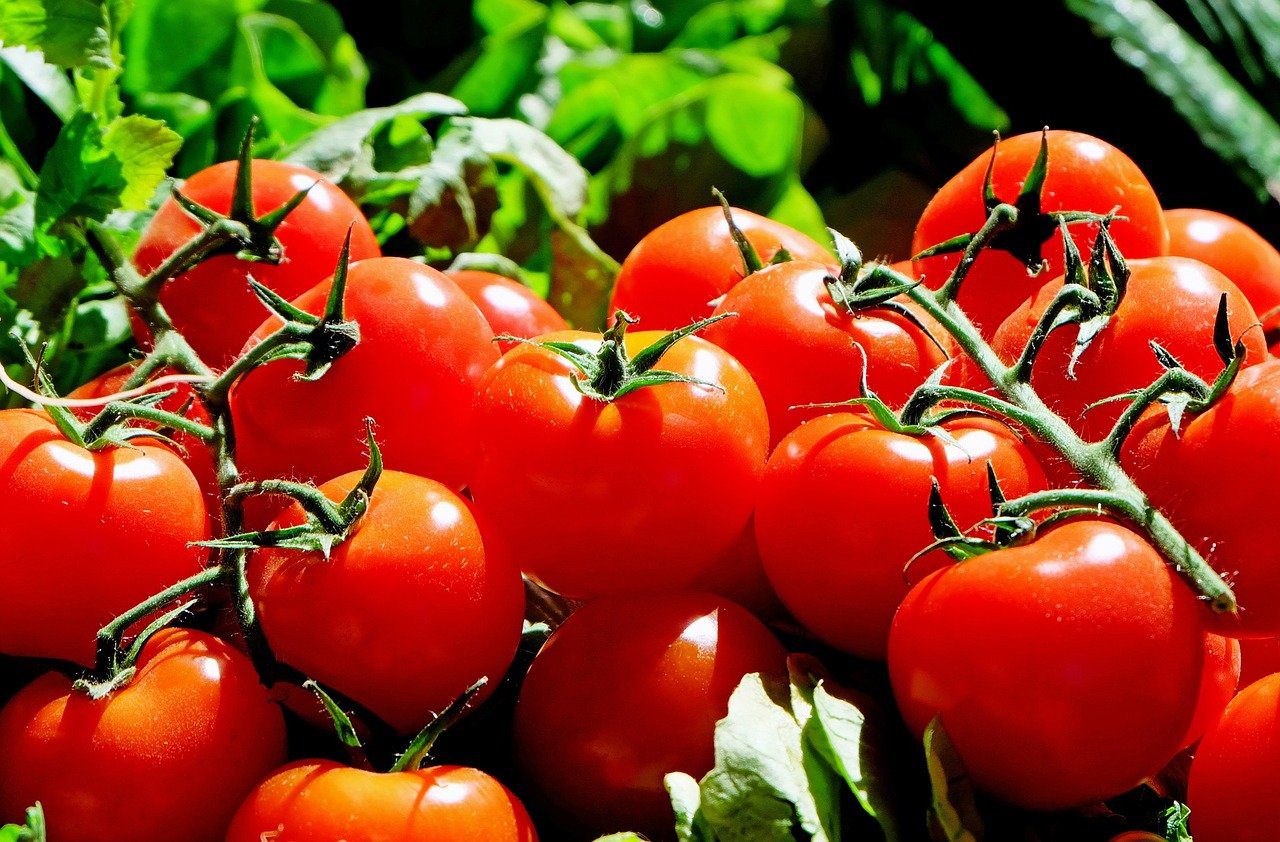
Tomato Plant Diseases
Tomato plants usually have a special place in all gardens. Gardeners plant, maintain, prune, fertilize, stake and care for their tomato plants with unparalleled dedication. Despite all this care and attention, sometimes a disease can strike the tomatoes. Let’s look at some of the most common diseases and how to prevent and manage them without using chemicals to control them.

Different Types of Diseases
Several pathogens can cause tomato plant diseases. It is important to briefly mention about the different types of pathogens and how to prevent them from hitting your garden in the first place.
Some tomato disease pathogens are fungal while others are bacterial or even viral. Infection rates depend on many factors such as wind, temperature, humidity, varietal resistance, plant health, etc.
Remember that tomato plants that are healthy and well maintained often have greater resistance to tomato plant diseases, so it is essential to ensure that your tomato crop has adequate moisture and that the soil is healthy and fertile.
Preventing Tomato Plant Diseases
In addition to making sure your tomato plants are happy and healthy, there are a few other things you can do to help prevent tomato plant diseases. Here are nine tips to help you get disease-free tomato plants.
- Rotate your crops. Since many tomato pathogens live in the soil, plant tomatoes in a different place in the garden each year.
- Immediately pinch the leaves with any signs of disease and discard them in the trash to prevent any spreading of the infection.
- Do not work in the garden when tomato foliage is wet, you may inadvertently spread pathogens from one plant to another.
- Choose disease-resistant varieties when choosing the types of tomatoes to grow.
- Remove all debris from diseased tomato plants at the end of the growing season and burn or discard in the garbage. Do not put diseased foliage in the compost pile.
- Ensure adequate air circulation around each plant. Space tomato plants 5 to 6 feet apart.
- Shred your tomato plants well at the beginning of the season. Two or three inches of compost, leaf mould, straw or hay is used to prevent fungal spores from the soil from splashing on the lower leaves when it rains.
- Keep the foliage dry. Manual irrigation hoses or garden hoses allow you to target water to the root zone. Splashes from overhead sprinklers can spread disease and wet foliage promotes fungal problems.
- Disinfect empty pots if you grow tomatoes in containers, using a 10% bleach solution at the end of the growing season, and replace worn potting soil with a new mix each spring.
The Six (6) Most Common Tomato Plant Diseases
Despite your best efforts to prevent tomato diseases, they may occasionally take hold in your garden. Here is an overview of the six (6) most common diseases, with information on identifying, preventing and managing each.
Late blight
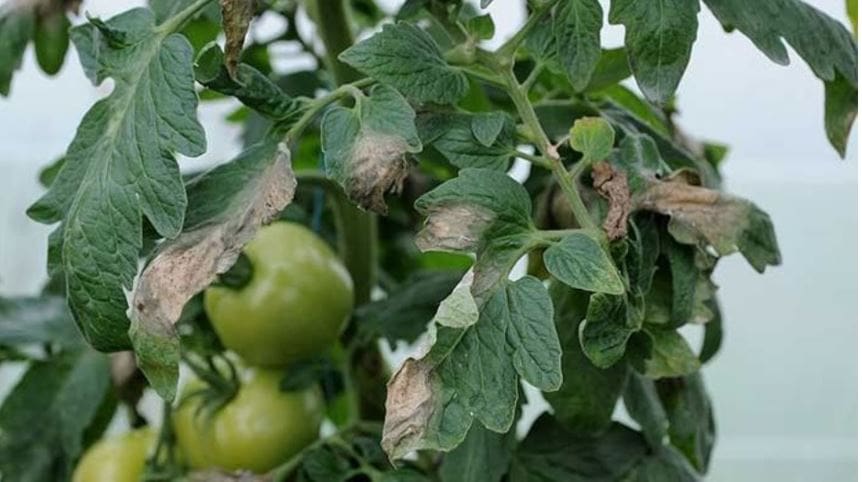
- Symptoms: This common tomato disease appears as brown bull’s-eye spots on the lower leaves of the plant. Often, the tissue around the spots turns yellow. Eventually, the infected leaves will fall off the plant. In most cases, the tomatoes will continue to ripen, even as the disease symptoms progress through the plant.
- Prevention: The late blight pathogen thrives in the soil, and once a garden has shown signs of the late blight fungus, it is there to stay because the organism overwinters easily in the soil, even in very cold climates. Fortunately, most tomatoes will continue to produce even in moderately severe cases of late blight. To prevent this fungal disease of tomatoes, shred the plants with a layer of newspapers covered with untreated cut grass, straw, leaf mould, or finished compost immediately after planting. This mulch forms a protective barrier, preventing soil spores from splashing into the soil and seeping into the plant.
- Treatment: Once the fungus is affected, organic fungicides based on Bacillus subtilis or copper can help prevent or stop the spread of this disease in tomato plants. Bicarbonate fungicides are also effective. (BiCarb, GreenCure, etc.)
Fusarium Wilt
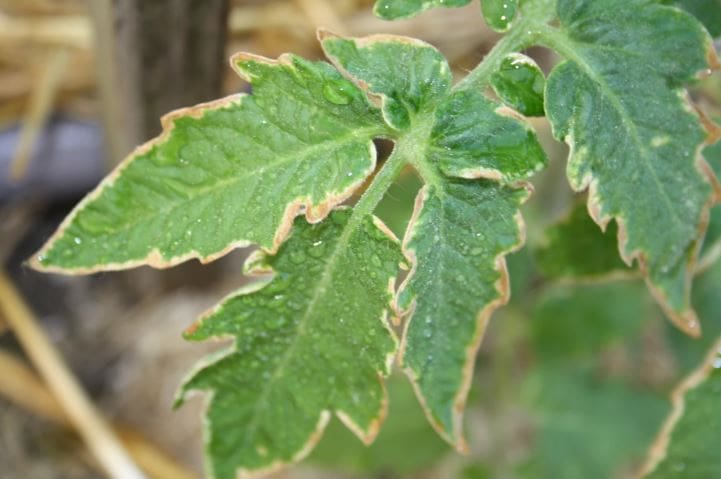
- Symptoms: The pathogen responsible for fusarium wilt (Fusarium oxysporum) is generally more common in hot southern climates where this disease can destroy entire fields. Symptoms include drooping leaves stem. Sometimes an entire branch may wilt, often starting at the lower part of the plant and then progressing upwards until the entire plant collapses. To confirm an infection, cut off the main stem of the plant and look for dark striations along the length of the stem. Sometimes there are also dark cankers at the base of the plant.
- Prevention: The spores of this tomato disease live in the soil and can survive for many years. They are spread by equipment, water, plant debris and even by humans and animals. The best method of prevention is to plant resistant varieties if you have had problems with fusarium wilt in the past. Also disinfect tomato cages, stakes and tools with a 10% bleach solution at the end of each season.
- Treatment: Once this disease of tomato plants has appeared, there is little you can do to control it. Instead, focus on prevention for years to come. Soil solarization can help kill fungal spores in the top few centimetres of soil, and crop rotation is essential. There are also several biological fungicide treatments that can be applied to the soil (look for one based on the Streptomyces griseoviridis bacterium called MycoStop® or one based on the fungus Trichoderma virens called Soil Guard®). These products can help prevent the infection from colonizing the roots of future crops.
Late blight Phytophthora infestans
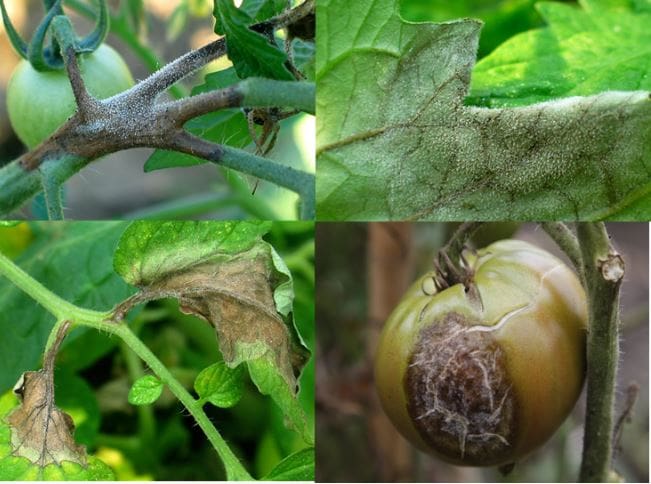
Late blight, caused by Phytophthora infestans, is an obligate parasite that can attack all the aerial organs of the plant. It is a common and extremely destructive disease of the tomato. Late blight affects field tomatoes more than greenhouse tomatoes unless greenhouse conditions are cool and humid. Phytophthora infestans also affects potato, bell pepper, eggplant, petunia and solanaceous weeds (especially nightshade (Solanum spp.)). In the field, tomatoes are infected if they are grown near potato fields attacked by late blight. In the greenhouse, the inoculum comes from infected potato fields nearby. Late blight develops rapidly if conditions are wet and the disease is not controlled. Crops can be destroyed within a few days. Once established, control of Phytophthora is difficult, if not impossible. Affected plants are distributed in outbreaks.
- Symptoms
Leaf: At the beginning, presence of greenish-black, oily and irregular spots at the apex or margin of the old leaves. This symptom is characteristic of the disease; in humid conditions, the spots enlarge rapidly to form brown patches with irregular contours. They are sometimes surrounded by a pale green halo. On the underside, a greyish-white mycelium develops at the margin of the spots. Sporulation may develop along the edges of the spots or beaches. The entire leaf may wilt, die. Brown cankers may develop from the leaf petiole.
Fruit: On green fruit, greenish-brown, oily, bumpy spots with an irregular margin may extend over the entire surface of the fruit. Potential rot. Presence of grayish-white mycelium on the epidermis.
Stem: Presence of irregular, dark brown to black spots, starting at the area where the leaf petiole attaches to the stem or at the stem apex. Under humid conditions, presence of mycelium. The spots rapidly expand and develop into cankers that can cover or encircle the entire stem. Infected stems are brittle, break easily and may die.
Plant: Partial or complete dieback. Smells like fish.
- Prevention: Different strains of mildew have emerged in recent decades. The spores of this disease spread rapidly, moving with the wind for miles around. It is not a common pathogen, but if late blight is reported in your area, there is little you can do to prevent the disease because of the spores spread so rapidly. Plant only locally grown plants to help keep the pathogen out of your area.
- Treatment: Once mildew strikes, there is little that can be done. Remove infested plants, put them in a garbage bag and discard them to prevent the disease from spreading. Organic fungicides based on Bacillus subtilis are somewhat effective in preventing this disease of tomato plants when it is found in your area.
Septoria leaf spot- Septoria lycopersici
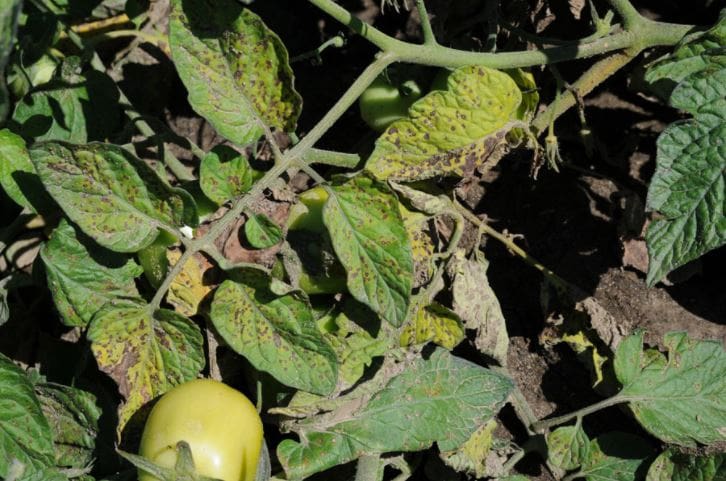
- Symptoms: The lower leaves are covered with small, round, brown spots that can reach 5-6 mm (1/4 in) in diameter. Tiny black fungal formations are visible in the centre of the lesions. Infected plants can rapidly lose their leaves if left untreated.
- Prevention: Remove diseased tomato plants at the end of the season to prevent the spores from overwintering in the garden. Cut and destroy infected leaves as soon as you see them and disinfect pruning equipment before moving from one plant to another.
- Treatment: Organic fungicides based on copper or Bacillus subtilis are effective against Septoria leaf spot, especially when used as a preventive measure.
Southern Bacterial Wilt
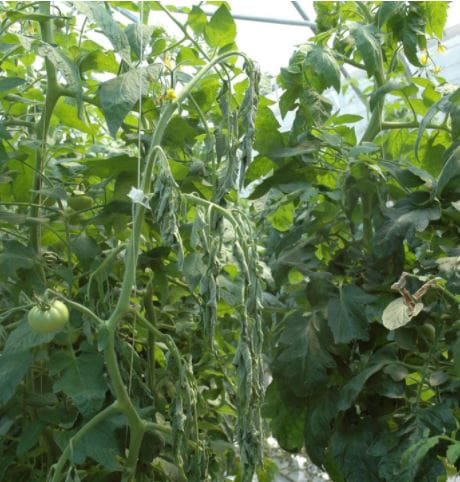
- Symptoms: Unfortunately, once present, southern bacterial wilt (Ralstonia solanacearum) is a disease of tomato plants that spreads like a cold sore. It is soil-borne, but the bacteria that cause this tomato disease can spread through soil, water, plant debris and even clothing, tools and skin. It is found naturally in greenhouses, but it can happen in the garden through infected plants that have been purchased. Initial symptoms include wilting of only a few leaves on a plant, while the rest of the foliage appears healthy. Over time, more and more leaves wilt and turn yellow until all the leaves succumb, although the stem remains upright. Fine threads of exudate come out of the cut stems, and when placed in water, milky sprays of bacteria come out of the cut.
- Prevention: Southern bacterial wilt is soil-borne and can survive for long periods in the soil on roots and plant debris. Like many other tomato diseases, it thrives in high temperatures and high humidity. The best way to prevent this disease is to buy and plant only locally grown plants or grow your own plants from seed. Southern bacterial wilt is more common in warmer regions, but it has also been observed in Massachusetts and other northern areas.
- Treatment: There is no cure for this disease. Once confirmed, infected plants should be immediately removed and discarded in the trash.
Vertical wilt
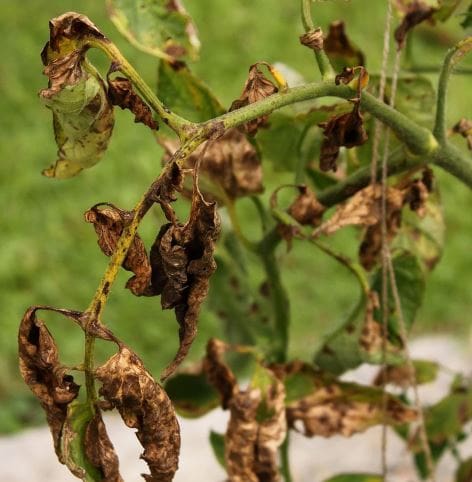
- Symptoms: This fungal disease is caused by several soil pathogens (Verticillium spp.). When present in a tomato plant, they block the vascular tissue of the plant and cause wilting of leaves and stems. Symptoms progress slowly, often one stem at a time. Eventually, the entire plant turns yellow and wilts. To confirm the diagnosis, cut off the main stem of the plant and look for a dark brown discoloration inside. Verticillium wilt is more problematic in late summer.
- Prevention: Verticillium fungi can survive for many years in the soil and on plants. They thrive in slightly cooler summer temperatures (between 70 and 80 degrees F). Plant only resistant varieties.
- Treatment: Once Verticillium wilt has occurred, there is little you can do to control this year’s infection. Instead, focus on preventing this disease in tomato plants in the coming years. Soil solarization will help kill the fungal spores in the top few centimetres of soil. Practice crop rotation: Do not plant other members of the same plant family in the same planting area for at least four years after infection.
